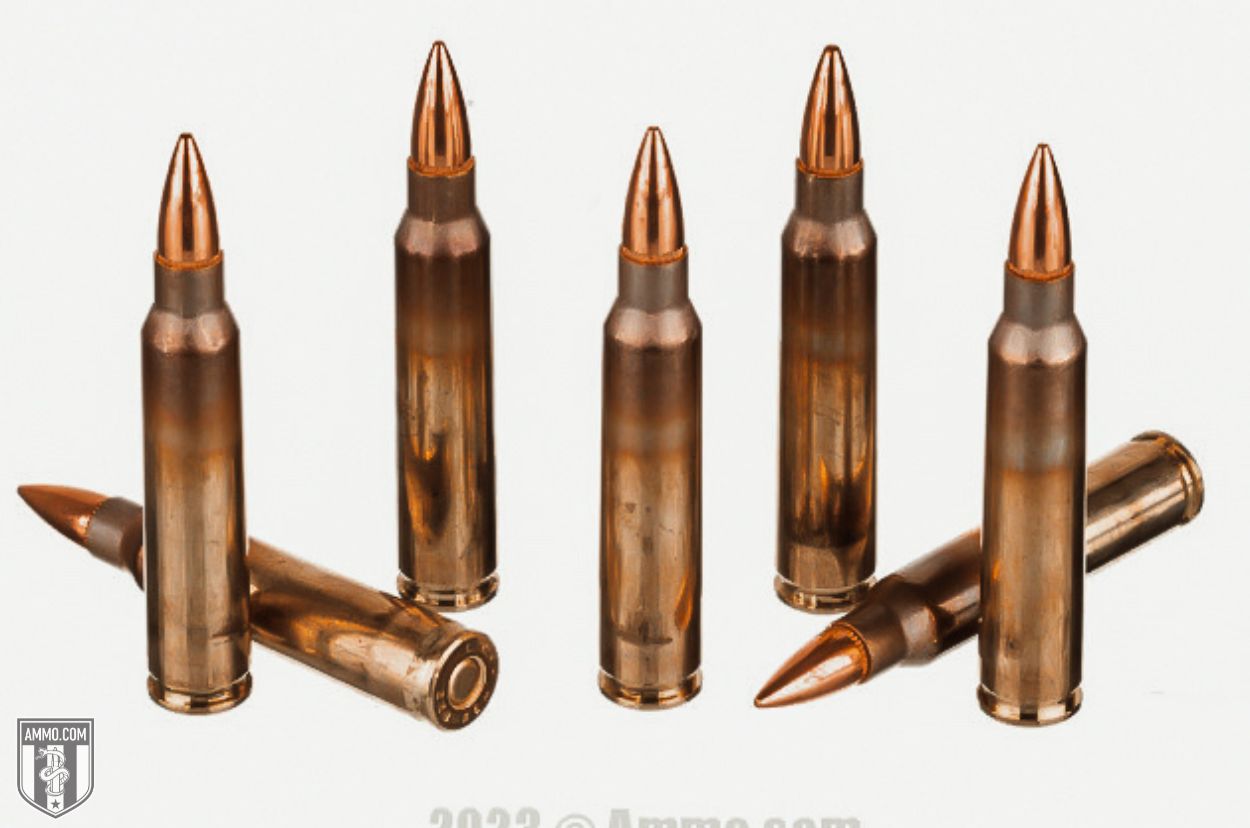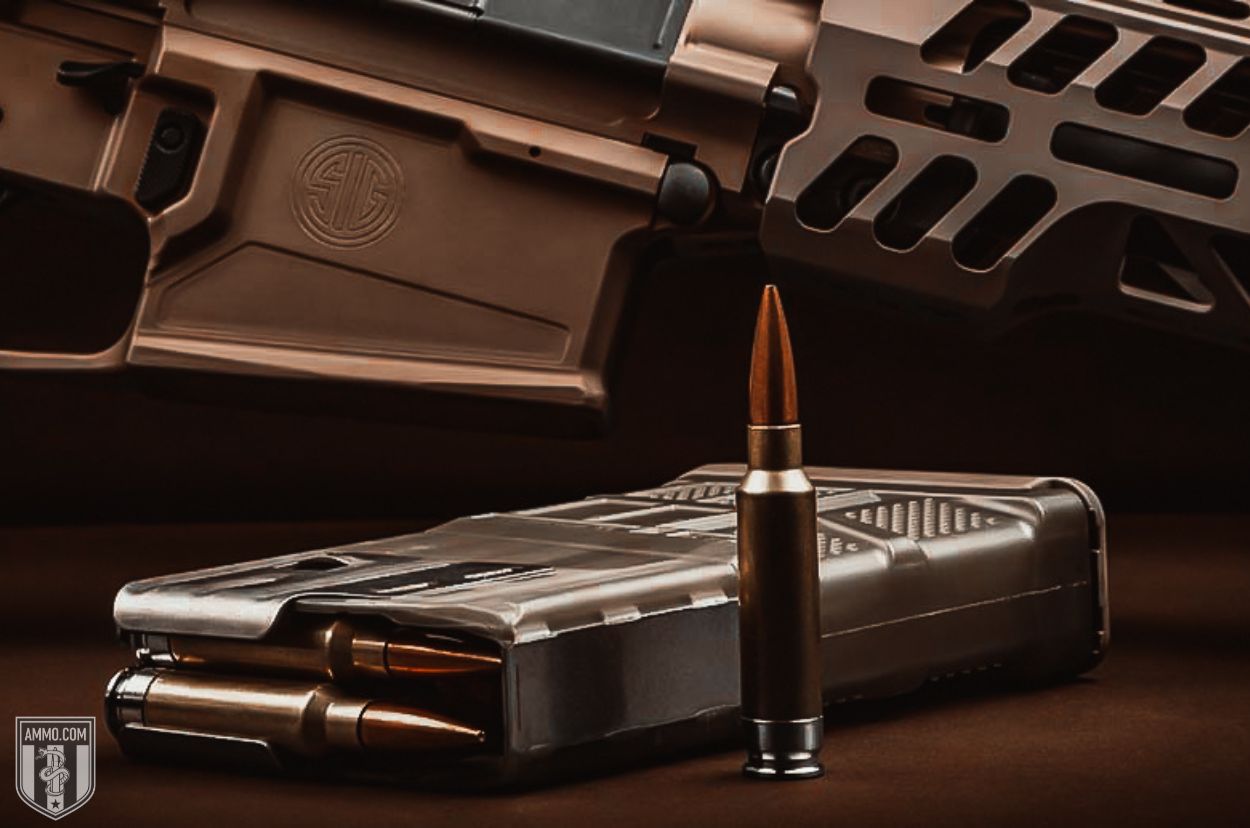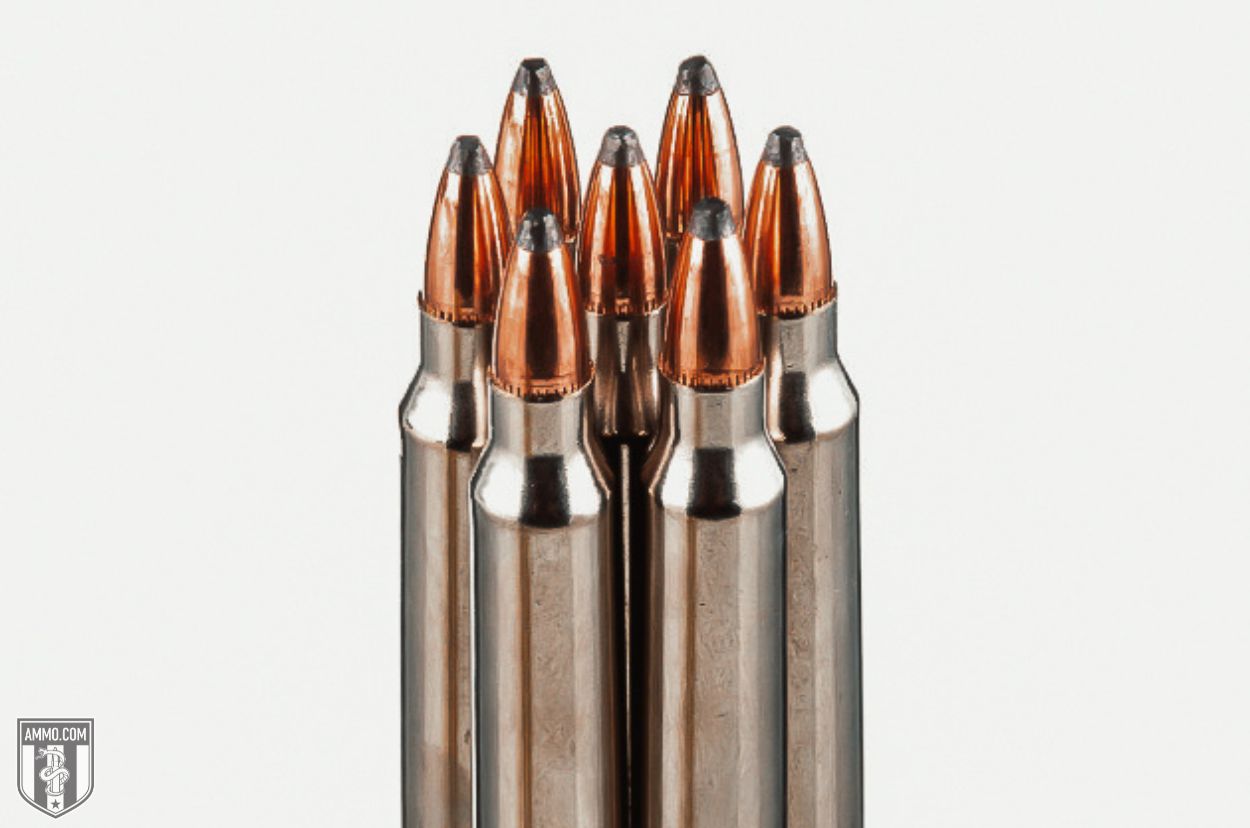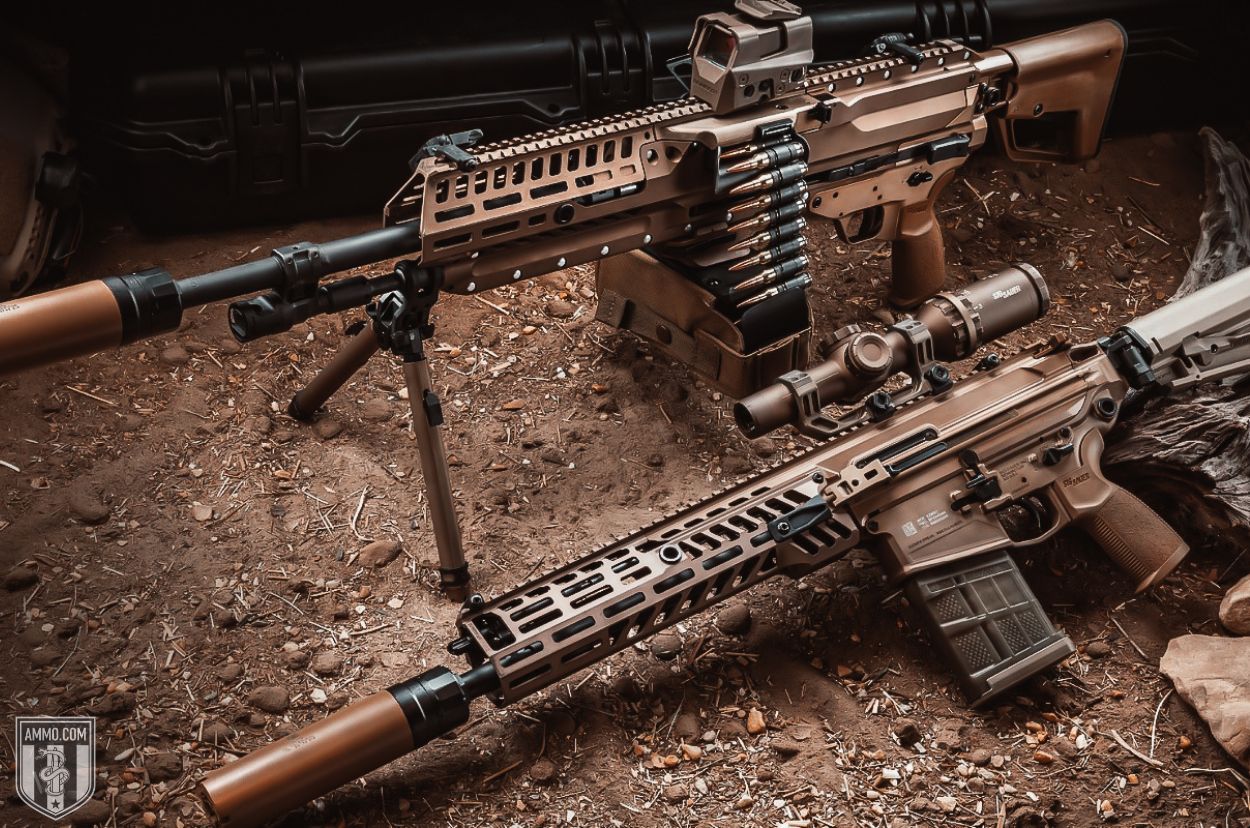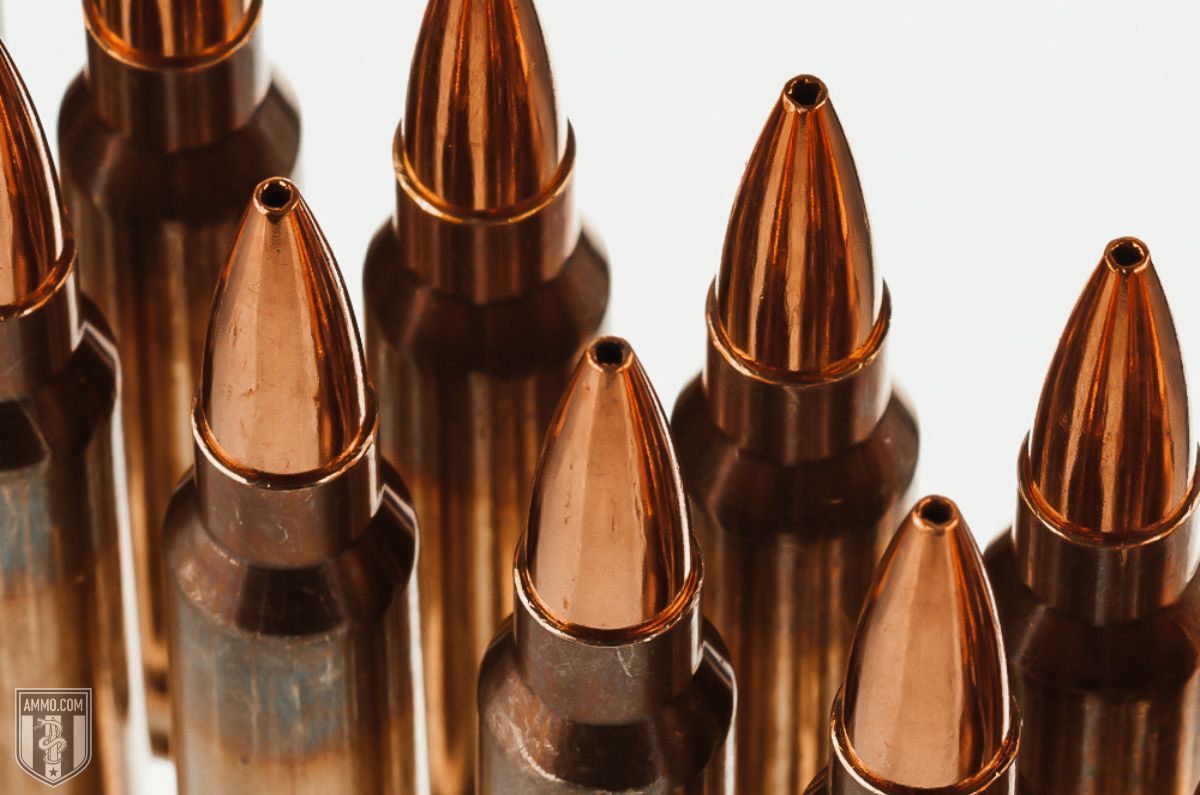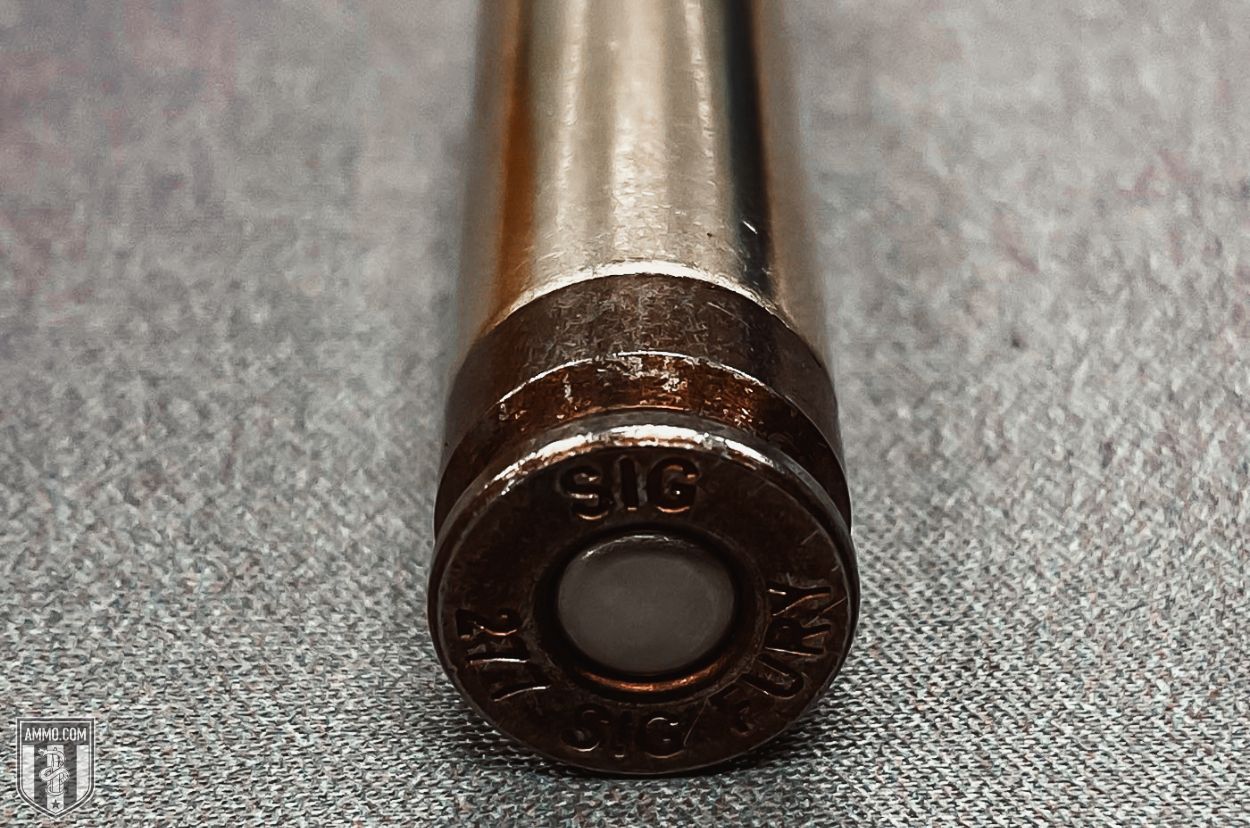The Big Debate: 277 Fury vs 223

After the US Army announced the 277 Fury would be the new rifle cartridge for the NGSW program, we immediately heard rumors that it was the 223 Rem or 5.56 NATO round killer.
But is this actually the case?
Below, we've compared the 277 Fury vs 223 across several scenarios so you can determine which round is best for you.
A Quick Note on Nomenclature
In this article, .223 Remington (223 Rem) and 5.56x45mm NATO (556 NATO) will be used interchangeably.
However, please understand that rifles chambered in .223 Rem differ from 5.56 NATO.
You should experience no issues shooting .223 ammo in your 5.56 NATO rifle, but not vice versa.
This is due to chamber pressure differences between the .223 Rem vs 5.56 NATO.
Bottom line: Know what round your rifle is chambered in (typically engraved on the barrel or receiver) and what pressures it can safely handle.
277 Fury Vs 223 Caliber Comparison
While many shooters want a head-on-head comparison of these rounds, it's never an apples-to-apples comparison. Each cartridge shines in certain instances over the other.
This is why we will rank each caliber and tally the wins at the article's end to decide which is truly best.
But first, let's begin with the cartridge specifications for each round.
277 Fury and 223 Rem Cartridge Specs
Holding both rounds in your hand, it's apparent the 277 Fury is a much larger round. Though it's believed not to have a parent case, it's eerily similar to a .308. As in, the 277 Fury has the same length and diameter as the .308 Win.
Many battle-hardened veterans believe the large size could be the greatest downfall of this round for soldiers because it drastically reduces the number of rounds a soldier can carry.
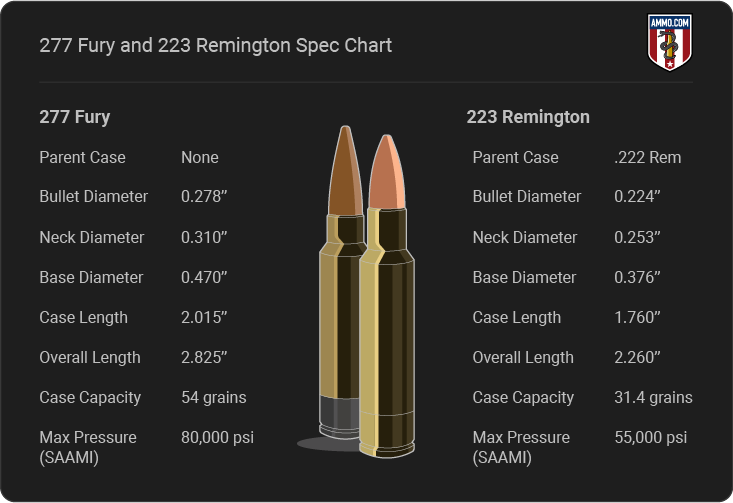
Besides the overall size of the rounds being dissimilar, the maximum pressure stands out the most. As a matter of fact, the 277 Fury has the highest chamber pressure of any round approved by SAAMI as of this writing.
The 80,000 psi of the 277 Fury is a much higher pressure than the 55,000 psi of the 223 Rem.
This drastic increase over other rounds is partly thanks to the three-piece hybrid case that is 20% lighter than a traditional solid brass case. It utilizes a brass body with an aluminum lock washer that connects to a stainless steel base (case head).
Ron Cohen, the President, and CEO of Sig Sauer, said this about the 277 Fury -
“The revolutionary SIG FURY ammunition is the most technically advanced leap in small arms ammunition in over 150 years; this turns your intermediate rifle platform into magnum performance without the added weight or length…"
Now, that's a bold statement, but when you see this new design... it's difficult to argue with him.
It would be tough to confuse these two rounds at the range, even though the US Military planned for the 277 Fury to replace the 5.56 NATO in many of its M4 carbines with the XM5 (Sig’s MCX Spear rifle) and XM250 (Sig’s MG-338) when it awarded Sig Sauer the Next Generation Squad Weapon Program (NGSW) contract.
Now, let's move on to how each round performs in the real world.
Recoil
One of the first things most shooters ask when shooting a new gun is, "How's the recoil?" or "How bad does it kick?"
I think this is a legitimate question. I asked my buddy the same question when I fired his 6.5 Creedmoor for the first time a few weeks ago.
It's not that I'm scared of the recoil; I just want to know what to expect, so here it is-
The 223 Rem has a felt recoil of just under 4 lbs. The first time my wife shot my AR-15 chambered in 5.56 NATO and 223 Rem, she was shocked at how little it kicked.
The 277 Fury has a felt recoil of about 20 lbs, similar to the recoil of a .308 Win.
That's a 5X difference in the amount of recoil!
If you're recoil-sensitive, this is a no-brainer; stick with the trusty 223 Rem.
Trajectory
The trajectory is how we measure the bullet's flight path based on bullet drop (in inches). In other words, how flat does it fly? Does it look like Kansas's topography or Colorado's?
The 277 Fury was initially designed to pierce near-peer body armor at long range, so we should expect a flat trajectory, especially with the kind of pressure this round produces.
Zeroed in at 100 yards with a 150gr polymer tipped Nosler bullet shot through a 16-inch barrel length, the 277 Fury has a drop of 3.1" at 200 yards, 24.6" at 400 yards, and 43.7" at 500 yards.
We have to zero in the 223 Rem at 200 yards to achieve similar results using a 55-grain bullet. At 300 yards, the bullet dropped 7.01"; at 400 yards, it dropped 21.48"; and at 500 yards, it dropped 46.24".
While these results may seem similar, remember there is a 100-yard difference between the zeros, and after 500 yards, the 223 Rem takes a nosedive, quite literally.
The 277 Fury, on the other hand, is just getting started.
That's why the 277 Fury easily wins the trajectory category. If you want a flat shooting round past 500 yards, the 277 Fury has the furthest effective range.
Accuracy
Determining the accuracy of a round is very difficult because of the many factors that go into determining accuracy.
You've got the bullet, gun, shooter, and conditions. So, I'll do my best to make as even of a comparison as possible.
Because the 223 Remington has less recoil and a reasonably flat trajectory out to 500 yards, more shooters will be more accurate with it inside of 500 yards.
However, once you pass 500 yards, the 277 Fury is more accurate, plus it shoots bullets with a much higher ballistic coefficient, which we will discuss next.
For close range, within 500 yards, go with the 223 Rem. But for long-range shooting, over 500 yards, choose the 277 Fury.
I still have to give the advantage to the 277 Fury because it can be just as accurate at close ranges if you can handle the increase in recoil.
Ballistic Coefficient
The ballistic coefficient (BC) is how aerodynamic a bullet is mathematically and how much it resists wind drift.
Heavier bullets generally have a higher BC. A higher BC means the bullet is more streamlined (aerodynamic), better resists crosswinds, and is less susceptible to wind drift than lower BC bullets.
Considering this, one would believe the 277 Fury should have the higher BC bullet, and one would be correct.
While every 223 Rem bullet technically has a different BC; a 55gr FMJ generally has a BC around 0.259.
The 150gr polymer tipped 277 Fury has a BC of .500; that's basically double.
The 277 Fury uses much more aerodynamic bullets and has a much higher ballistic coefficient.
Stopping Power
I'll keep this short and sweet: the 277 Fury was designed to have more stopping power than the 223 Rem. That was one of the US Army's requirements for the new cartridge.
It has a larger bullet, more powder, and high pressure, all good indicators that the 277 Fury will stop a threat or animal better than the 223.
The 277 Fury easily wins this category.
Hunting
Though it's still relatively unproven in the hunting realm, all indicators point to the new Sig Fury cartridge taking the hunting world by storm.
Though the 277 Fury won't be able to be used in states that only allow straight-walled cartridges, it will still outperform a 223 Rem in all scenarios where both cartridges are legal, especially hunting in the mountains where a longer range round like the 6.8 SPC is often needed.
This is because the 223 is way too undersized to be used as an effective hunting round other than for varmints, and some states allow it to be used on deer.
This is another category that goes to the 277 Fury.
Home Defense
I know what you're thinking: the 277 Fury is about to run off with the win, but, as my grandpa says, "Hold your horses. We're not done yet".
Yes, the 277 Fury has more stopping power. Yes, it's better for hunting.
No, it's not better for self-defense.
The AR platform chambered in 5.56 NATO (223 Remington) has proven incredibly effective in close-quarter combat scenarios, including home defense situations.
This is because most bad guys breaking into homes are not wearing body armor, and the 223 bullet is much less likely to over-penetrate into the neighbor's house.
Two other reasons I prefer the 223 Rem over the 277 Fury for home defense are the higher magazine capacity of the 223 and the lower recoil of the 223.
I'll still grab my AR-15 chambered in 5.56/223 for home defense situations when my shotgun is not available.
The 223 takes this category.
Ammo and Rifle Cost
Let's be honest: the budget is a significant concern for the average shooter.
I wish I had an endless amount of money to spend on guns and ammo, but I don't, so I must make the dollars stretch where I can.
Because the 223 Remington has been around for decades (it was the American round of choice in Vietnam), it's readily available and often reasonably priced (Yes, I know it's been ridiculously overpriced in the past).
It's pretty easy to find 223 ammo for $0.50-$0.70 per round, especially when you buy 223 rounds in bulk.
223 rifles are also easy to find and reasonably priced. You can get a bolt-action Winchester XPR, which is a short-action hunting rifle chambered in 223 Rem, for just over $500. At the same time, most 223 Rem AR-15s will cost you $600-$1,000.
However, the 277 Fury is an entirely different story. The rifles and ammo are not readily available because it's still a relatively new round.
Ammo availability is minimal because most of it is being produced at the Lake City Ammunition Plant for the US Military. And the armory is not currently producing rounds for civilian use.
277 Fury rifles are also incredibly expensive compared to 223 Remington rifles. A Sig Cross Rifle chambered in 277 Fury is very difficult to find, and when you do, it will cost you every bit of $2,000+.
It gets even pricier if you want to purchase the MCX-SPEAR with an SLX suppressor, which claims to be "[T]he most innovative and advanced AR platform in the world." By the time the cashier totals your cost for the rifle, you'll spend well over $2,600.
It should be clear unless you have money bags weighing you down, the 223 Rem comes out ahead in this category.
However, I see the prices of 277 Fury ammo and rifles dropping as more shooters become aware of the round and more companies like Federal, Hornady, Remington, and Winchester begin producing rifles and ammo for this caliber.
Reloading
One way to save a little money on ammo is to reload.
All the information and components you need to reload 223 rounds are readily available. On the other hand, the 277 Fury is still a very new cartridge, so it lacks the reloading information and supplies needed to reload the 277 Fury rounds.
I'm also curious to see how the 277 Fury reloads since it has a three-piece hybrid casing, unlike 6.5 Grendel ammo and 338 Lapua ammo.
The 223 Rem also wins this category because it's currently much easier to get started reloading. However, this could quickly become a tie in the future.
Ballistics 277 Fury Vs 223 Remington
Below, the team at Ammo.com has taken the liberty to create a couple of ballistics tables for the 277 Fury and the 223 Rem.
These ballistics tables include the muzzle velocity (FPS), muzzle energy (ft-lbs), and trajectory of the bullets.
.277 Fury Ballistics
Note: This information comes from the manufacturer and is only informational. The actual ballistics obtained with your firearm can vary considerably from the advertised ballistics. Also, ballistics can vary from lot to lot with the same brand and type load.
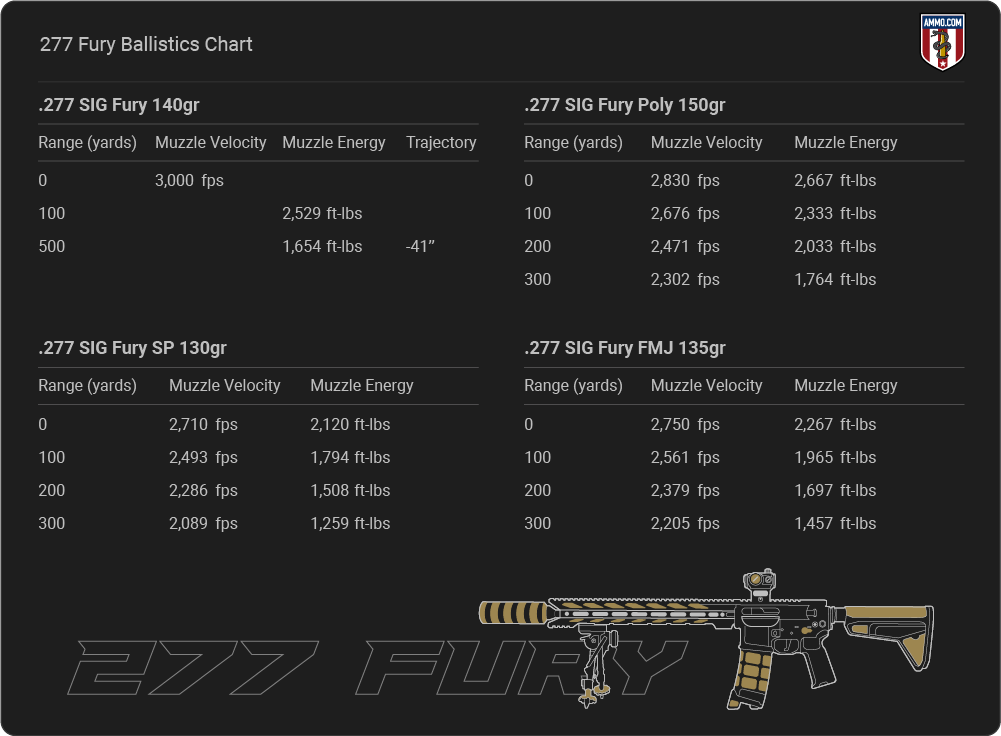
.223 Ballistics
Note: This information comes from the manufacturer and is only informational. The actual ballistics obtained with your firearm can vary considerably from the advertised ballistics. Also, ballistics can vary from lot to lot with the same brand and type load.
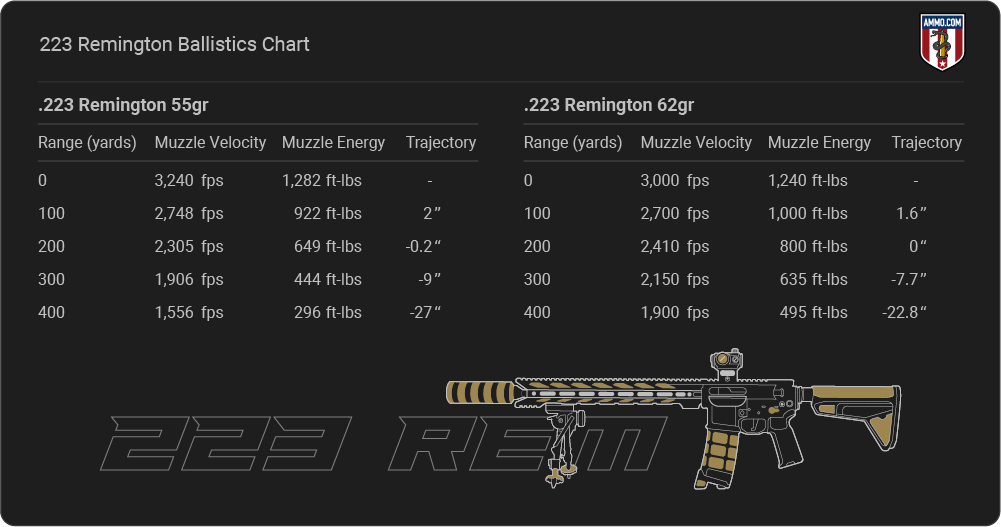
.277 SIG Fury History
The 277 Sig Fury is a new cartridge Sig Sauer created for the Next Generation Squad Weapons (NGSW) military procurement solicitations.
The exact details of the development of the 277 Fury are still classified, but we know the US Army needed it to pierce current and future body armor at 500 yards.
The creation of the 277 Fury was first announced at the end of 2019. However, the SAAMI committee members couldn't meet until 2021 to decide on approving the new cartridge due to COVID-19 travel restrictions.
It was eventually approved and is currently being produced at Lake City Arsenal. As civilians, we're patiently waiting for more companies to add the 277 Fury to their ammo lineup.
.223 History
The .223 Rem was created from an experimental cartridge designed at the request of the U.S. military, according to Cartridges of the World.
In 1957, the United States Continental Army Command (CONARC) asked for a lightweight rifle that shot a variation of .22 caliber ammunition.
By early 1962, the specifications of the 223 Rem were turned into the Sporting Arms and Ammunition Manufacturers’ Institute (SAAMI). In July 1962, testing ended as SAAMI recommended proceeding with the .223 Remington.
In 1964, the U.S. Army officially adopted the .223 Remington as the 5.56mm ball cartridge M193, eventually becoming the 5.56x45mm NATO.
This ammunition was first used in the Army’s new M-16 rifles during the Vietnam War, where it proved deadly and effective.
Today, 223 or 5.56 NATO is one of America's most popular, if not the most popular, calibers.
For those looking to purchase these rounds in large quantities, we offer competitive deals on bulk 5.56 ammo to meet all your shooting needs.
Frequently Asked Questions
Below, the team at Ammo.com has gathered and answered some of the most commonly asked questions regarding the 277 Sig Fury vs 223 Rem.
What does the 277 Fury compare to?
The 277 Fury compares to a .308 Win and .270 Win best. However, it was designed to replace the 5.56 NATO on the battlefield.
What is the issue with 277 Fury?
The issue with 277 Fury is the incredibly high chamber pressure and the lack of current availability.
What is the difference between 6.5 Creedmoor and 277 Fury?
The difference between 6.5 Creedmoor and 277 Fury is that the 277 Fury shoots much flatter (6-9 feet less bullet drop) at 1,000 yards and has 20-25% more terminal energy.
What is the difference between 223 and 277?
The difference between 223 and 277 is that the 277 shoots a larger bullet at a higher pressure, giving it better long-range performance and energy retention.
Parting Shots
Now that you've finished reading our article on 277 Fury Vs 223 Rem, you understand why the 277 Fury isn't going to obliterate the 223 Remington for many reasons.
However, if you kept track of category wins, you know that the 277 Fury won 5/9 categories. Making it the winner by 1.
Overall, these rounds have their place, and I expect both will be a popular choice for shooters in the future.
Ammo Comparisons
- .308 vs 5.56
- 6.5 Creedmoor vs .308
- .300 Blackout vs .308
- .300 Win Mag vs .308
- .243 vs .308
- .308 vs .30-06
- 7mm-08 vs .308
- .270 vs .308
- 7.62x39 vs .308
- .223 vs .308
- .338 Lapua vs .308
- .380 ACP vs 9mm
- .223 vs 5.56
- .300 Blackout vs 5.56
- 9mm vs 45 ACP
- 9mm vs 40 S&W
- .357 SIG vs 9mm
- 10mm vs 9mm
- 9mm vs 9mm Luger
- .243 vs .270
- .300 Win Mag vs .30-06
- .270 vs .30-06
- .40 vs .45
- 38 Special vs 357
- 9mm vs 40 vs 45
- 5.56 vs 7.62x39
- 338 Lapua vs .30-06
- .30-30 vs .30-06
- 300 PRC vs 338 Lapua
- .30-06 vs 7mm
- 300 Win Mag vs 338 Lapua
- 300 PRC vs 300 Win Mag
- 300 WSM vs 300 Win Mag
- 338 Win Mag vs 338 Lapua
- 12 Gauge vs 20 Gauge
- 10mm vs 357 Mag
- .30-30 vs 7.62x39
- 224 Valkyrie vs 22-250
- 17 HMR vs 22 Mag
- 7.62x39 vs .300 Blackout
- 45 ACP vs 45 Auto
- 45-70 vs 30-30
- 300 Blackout vs 223
- 357 Magnum vs 9mm
- 350 Legend vs 300 Blackout
- 224 Valkyrie vs 223
- 45 ACP vs 38 Super
- 6.5 Grendel vs .308
- 17 HMR vs 22 LR
- 10 Gauge vs 12 Gauge
- 22-250 vs 223
- 45 Colt vs 45 ACP
- 350 Legend vs 30-30
- 5.7x28 vs 223
- 5.7 vs 9mm
- 5.56 vs 5.7
- 22 vs 9mm
- Buckshot vs Birdshot
- 450 Bushmaster vs 308
- 450 Bushmaster vs 223
- Buckshot vs Slug
- 6.5 Grendel vs 5.56 vs 223
- 6mm ARC vs 6.5 Grendel
- 44 vs 45
- 458 SOCOM vs 5.56
- 357 vs 44
- 32 ACP vs 380
- 300 Win Mag vs 338 Win Mag vs 338 Lapua Mag
- 450 Bushmaster vs 458 SOCOM vs 50 Beowulf
- 6mm Creedmoor vs 6.5 Creedmoor
- TMJ vs FMJ
- 44 Special Vs 44 Magnum
- 45 90 vs 45 70
- 6.8 Western vs 6.8 SPC
- 50 Beowulf vs 50 BMG
- 26 Nosler vs 6.5 PRC
- 28 Gauge vs 410
- 6.8 SPC vs 5.56
- 6.8 SPC vs 6.5 Grendel
- 6.8 Western vs 7mm Rem Mag vs .28 Nosler
- 6.8 Western vs 6.5 Creedmoor
- 22 Hornet vs 223
- 6.8 Western vs 6.5 PRC
- .410 vs 12 Gauge
- .410 vs 20 Gauge
- 22 LR vs 22 Mag
- 6mm ARC vs 243
- 7mm-08 vs 270
- 243 vs 6.5 Creedmoor
- Nickel vs Brass Casing
- 204 Ruger vs 223
- 50 Beowulf vs 5.56
- 260 Remington vs 6.5 Creedmoor
- 6mm Remington vs 243
- 28 Nosler vs 300 PRC
- 50 Beowulf vs 50 AE
- 22 Nosler vs 22-250
- 450 Marlin vs 45-70
- 300 Win Mag vs 300 Norma
- 458 SOCOM vs 300 Blackout
- 38-55 vs 45-70
- 22 Hornet vs 22 LR
- 300 Norma vs 338 Lapua
- 338 Lapua vs 50 BMG
- 28 Nosler vs 300 Win Mag
- 28 Nosler vs 6.5 Creedmoor
- 204 vs 22-250
- 458 SOCOM vs 45 70
- 44 40 vs 45 70
- 6.8 SPC vs 6.5 Creedmoor
- 450 Bushmaster vs 30-06
- 7mm Rem Mag vs 300 Win Mag
- 30 Carbine vs 223
- 25-06 vs 30-06
- 26 Nosler vs 28 Nosler
- 16ga vs 12ga
- 30 06 vs 7.62 x54R
- 9mm Makarov vs 9mm Luger
- 350 Legend vs 223
- 30 Carbine vs 5.56
- 6.5x55 vs 6.5 Creedmoor
- 6.5 Creedmoor vs 270 vs 25-06
- M193 vs M855
- 450 Bushmaster vs 458 SOCOM
- 6.5 Grendel vs 6.5 Creedmoor
- 350 Legend vs 5.56
- .277 Fury vs 6.8 SPC
- 277 Fury vs 300 Win Mag
- 10mm vs .45 ACP
- 277 Fury vs 223
- 6.8 SPC vs 300 Blackout
- 6.5 PRC vs 6.5 Creedmoor
- 277 Fury vs 308
- 277 Fury vs 6.5 Creedmoor
- 350 Legend vs 450 Bushmaster
- 277 Fury Vs 5.56 NATO
- 10mm vs 40S&W
- 32 ACP vs 9mm
- 32 Special vs 9mm
- 8.6 Blackout vs 300 Blackout
- 30 Super Carry vs. 9mm
- 5.56 vs 9mm
- .50 Action Express vs 9mm
- 7.62x25 vs. 9mm
- 10mm vs 44 Magnum
- 300 Blackout vs 300 Win Mag
- 6.5 Grendel vs 300 Blackout
- 460 Rowland vs 10mm
- 300 RUM vs 300 PRC
- 300 Norma vs 300 PRC
- 45 GAP vs 45 ACP
- 7mm PRC vs 300 Win Mag
- 300 PRC vs 6.5 Creedmoor
- 300 PRC vs 308
- 357 SIG vs 357 Mag
- 7.62x39 vs 7.62x51
- 243 Win vs 223 Rem
- 30 Nosler vs 300 PRC
- 6.5 Creedmoor vs. 30-06 Springfield
- 450 S&W vs. 44 Magnum
- 6.5 Creedmoor vs. 300 Win Mag
- 454 Cassull vs. 45-70 Govt
- 454 Cassull vs. 44 Mag
- 7.62x54r vs. 308 Winchester
- 22 ARC vs. 223 Rem
- Subsonic vs. Supersonic Ammo
